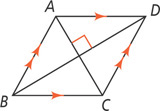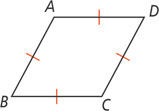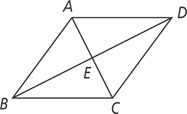6-5 Conditions for Rhombuses, Rectangles, and Squares
Objective
To determine whether a parallelogram is a rhombus or rectangle
 Dynamic Activity
Dynamic Activity
Special Parallelograms
Essential Understanding You can determine whether a parallelogram is a rhombus or a rectangle based on the properties of its diagonals.
Take note Theorem 6-16
Theorem
If the diagonals of a parallelogram are perpendicular, then the parallelogram is a rhombus.
If …
ABCD is a

Then …
ABCD is a rhombus

Proof Proof of Theorem 6-16
Given:
ABCD is a parallelogram,
Prove: ABCD is a rhombus.

Since ABCD is a parallelogram,
Table of Contents
- 6-1 The Polygon Angle-Sum Theorems
- 6-2 Properties of Parallelograms
- 6-3 Proving That a Quadrilateral Is a Parallelogram
- 6-4 Properties of Rhombuses, Rectangles, and Squares
- 6-5 Conditions for Rhombuses, Rectangles, and Squares
- 6-6 Trapezoids and Kites
- 6-7 Polygons in the Coordinate Plane
- 6-8 and 6-9 Coordinate Geometry and Coordinate Proofs





